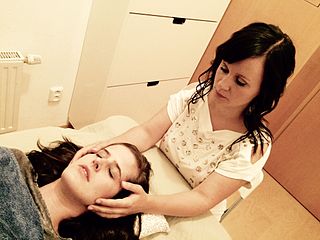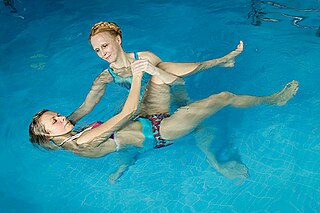
Massage is the rubbing or kneading of the body's soft tissues. Massage techniques are commonly applied with hands, fingers, elbows, knees, forearms, feet or a device. The purpose of massage is generally for the treatment of body stress or pain. In European countries, a person professionally trained to give massages is traditionally known as a masseur (male) or masseuse (female). In the United States, these individuals are often referred to as "massage therapists". In some provinces of Canada, they are called "registered massage therapists."
Occupational therapists (OTs) are health care professionals specializing in occupational therapy and occupational science. OTs and occupational therapy assistants (OTAs) use scientific bases and a holistic perspective to promote a person's ability to fulfill their daily routines and roles. OTs have training in the physical, psychological, and social aspects of human functioning deriving from an education grounded in anatomical and physiological concepts, and psychological perspectives. They enable individuals across the lifespan by optimizing their abilities to perform activities that are meaningful to them ("occupations"). Human occupations include activities of daily living, work/vocation, play, education, leisure, rest and sleep, and social participation.

Occupational therapy (OT) is a healthcare profession that involves the use of assessment and intervention to develop, recover, or maintain the meaningful activities, or occupations, of individuals, groups, or communities. The field of OT consists of health care practitioners trained and educated to improve mental and physical performance. Occupational therapists specialize in teaching, educating, and supporting participation in any activity that occupies an individual's time. It is an independent health profession sometimes categorized as an allied health profession and consists of occupational therapists (OTs) and occupational therapy assistants (OTAs). While OTs and OTAs have different roles, they both work with people who want to improve their mental and or physical health, disabilities, injuries, or impairments.
Gestalt Theoretical Psychotherapy(GTP) is a method of psychotherapy based strictly on Gestalt psychology. Its origins go back to the 1920s when Gestalt psychology founder Max Wertheimer, Kurt Lewin and their colleagues and students started to apply the holistic and systems theoretical Gestalt psychology concepts in the field of psychopathology and clinical psychology. Through holism, "a person's thinking, feeling, actions, perceptions, attitudes and logical operations" are seen as one unity. Many developments in psychotherapy in the following decades drew from these early beginnings, like e.g. group psychoanalysis (S. Foulkes), Gestalt therapy (Laura Perls, Fritz Perls, Goodman, and others), or Katathym-imaginative Psychotherapy (Hanscarl Leuner).
Gestalt therapy is a form of psychotherapy that emphasizes personal responsibility and focuses on the individual's experience in the present moment, the therapist–client relationship, the environmental and social contexts of a person's life, and the self-regulating adjustments people make as a result of their overall situation. It was developed by Fritz Perls, Laura Perls and Paul Goodman in the 1940s and 1950s, and was first described in the 1951 book Gestalt Therapy.

Craniosacral therapy (CST) or cranial osteopathy is a form of alternative medicine that uses gentle touch to feel non-existent rhythmic movements of the skull's bones and supposedly adjust the immovable joints of the skull to achieve a therapeutic result. CST is a pseudoscience and its practice has been characterized as quackery. It is based on fundamental misconceptions about the anatomy and physiology of the human skull and is promoted as a cure-all for a variety of health conditions.
Reality therapy (RT) is an approach to psychotherapy and counseling developed by William Glasser in the 1960s. It differs from conventional psychiatry, psychoanalysis and medical model schools of psychotherapy in that it focuses on what Glasser calls "psychiatry's three Rs" – realism, responsibility, and right-and-wrong – rather than mental disorders. Reality therapy maintains that most people suffer from socially universal human conditions rather than individual mental illnesses, and that failure to attain basic needs leads to a person's behavior moving away from the norm. Since fulfilling essential needs is part of a person's present life, reality therapy does not concern itself with a person's past. Neither does this type of therapy deal with unconscious mental processes.
In Australia, Diversional Therapy “is a client centred practice [that] recognises that leisure and recreational experiences are the right of all individuals.” Diversional Therapists promote the involvement in leisure, recreation and play by reducing barriers to their client's participation and providing opportunities where the individual may choose to participate and perform their occupation. Ideally these recreational activities promote self-esteem and personal fulfillment, through an emphasis on holistic care; providing physical, psychological, social, intellectual and spiritual/cultural/temporal support.

The stone massage is a form of alternative medicine massage therapy and bodywork involving the placement of either heated or cooled stones to the body for the purpose of pain relief, relaxation and therapy. There are many variations and techniques used in the application of stone massage therapy, deriving from a variety of traditional practices. Stone massages are primarily used to alleviate physical pain issues, however, are also used to promote emotional and spiritual wellbeing in practice.
Online counseling is a form of professional mental health counseling that is generally performed through the internet. Computer aided technologies are used by the trained professional counselors and individuals seeking counseling services to communicate rather than conventional face-to-face interactions. Online counseling is also referred to as teletherapy, e-therapy, cyber therapy, or web counseling. Services are typically offered via email, real-time chat, and video conferencing. Some clients use online counseling in conjunction with traditional psychotherapy, or nutritional counseling. An increasing number of clients are using online counseling as a replacement for office visits.
Motivational interviewing (MI) is a counseling approach developed in part by clinical psychologists William R. Miller and Stephen Rollnick. It is a directive, client-centered counseling style for eliciting behavior change by helping clients to explore and resolve ambivalence. Compared with non-directive counseling, it is more focused and goal-directed, and departs from traditional Rogerian client-centered therapy through this use of direction, in which therapists attempt to influence clients to consider making changes, rather than engaging in non-directive therapeutic exploration. The examination and resolution of ambivalence is a central purpose, and the counselor is intentionally directive in pursuing this goal. MI is most centrally defined not by technique but by its spirit as a facilitative style for interpersonal relationship.

A massage chair is a chair designed for massages. It can refer to two types of products. Traditional massage chairs allow a massage therapist to easily access the head, shoulders, and back of a massage recipient, while robotic massage chairs use electronic vibrators and motors to provide a massage.
Motivational therapy is a combination of humanistic treatment and enhanced cognitive-behavioral strategies, designed to treat substance use disorders. It is similar to motivational interviewing and motivational enhancement therapy.
Medical massage is outcome-based massage, primarily the application of a specific treatment targeted to the specific problem the patient presents with a diagnosis and are administered after a thorough assessment/evaluation by the medical massage therapist with specific outcomes being the basis for treatment. It is also known as clinical massage or treatment massage.
The Complementary and Natural Healthcare Council (CNHC) is a regulatory body in the United Kingdom which provides a voluntary register of complementary, rather than alternative medicine, therapists. The key purpose of CNHC is to act in the public interest and enable proper public accountability of the complementary therapists that it registers.
Daseinsanalysis is an existentialist approach to psychoanalysis. It was first developed by Ludwig Binswanger in the 1920s under the concept of "phenomenological anthropology". After the publication of "Basic Forms and Perception of Human Dasein", Binswanger would refer to his approach as Daseinsanalysis. Binswanger's approach was heavily influenced by the German philosopher Martin Heidegger and psychoanalysis founder Sigmund Freud. The philosophy of daseinsanalysis is centered on the thought that the human Dasein is open to any and all experience, and that the phenomenological world is experienced freely in an undistorted way. This way initially being absent from meaning, is the basis for analysis. This theory goes opposite to dualism in the way that it proposes no gap between the human mind and measurable matter. Subjects are taught to think in the terms of being alone with oneself and grasping concepts of personhood, mortality and the dilemma or paradox of living in relationship with other humans while being ultimately alone with oneself. Binswanger believed that all mental issues stemmed from the dilemma of living with other humans and being ultimately alone.
Canine massage is a branch of massage therapy that promotes health in dogs. Specifically, canine massage therapy is a form of alternative therapy, the benefits of which may include relaxation, increased oxygenation, relief from pain, improved joint flexibility, and miscellaneous benefits to the immune system. It uses touch to maintain or improve both physical and emotional well-being. However, an owner should consult with a veterinarian before attempting to massage their dog themselves.
This article is about physical therapy in carpal tunnel syndrome.

Watsu is a form of aquatic bodywork used for deep relaxation and passive aquatic therapy. Watsu is characterized by one-on-one sessions in which a practitioner or therapist gently cradles, moves, stretches, and massages a receiver in chest-deep warm water.
Many health organizations around the world have denounced and criticized sexual orientation and gender identity change efforts. National health organizations in the United States have announced that there has been no scientific demonstration of conversion therapy's efficacy in the last forty years. They find that conversion therapy is ineffective, risky and can be harmful. Anecdotal claims of cures are counterbalanced by assertions of harm, and the American Psychiatric Association, for example, cautions ethical practitioners under the Hippocratic oath to do no harm and to refrain from attempts at conversion therapy.







